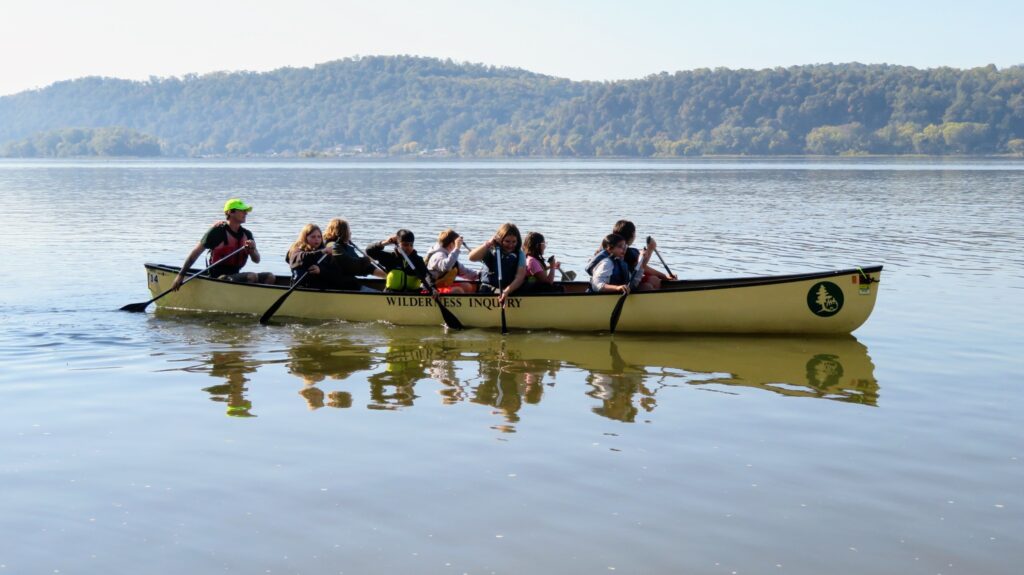Education is one of the most valuable resources that the National Trails System has to offer. 2022 hosted a robust array of educational opportunities for both youth and adults helping to foster deeper relationships with landscapes and histories across the nation.
The successful youth education programs that took place last year will provide the foundation for a new generation of trail enthusiasts and stewards. Over the course of last summer, 425 new Junior Ranger Anglers joined the forces protecting, enjoying, and caring for the Captain John Smith Chesapeake National Historic Trail. Participants not only learned how to fish, but also about the history and heritage of the Chesapeake Bay, including traditional fishing practices, Indigenous and colonial history in the area, and the role ecosystems of the Bay play in contemporary life.
The Overmountain Victory Trail Association (OVTA), in cooperation with over 25 partner sites and organizations, hosted day-long educational programs throughout the Overmountain Victory National Historic Trail that took place within a three-week span of the Annual Commemorative March to Kings Mountain.
The Lewis and Clark National Historic Trail Junior Ranger Program and its designer, Caitlin Campbell, were awarded the National Park Service’s Freeman Tilden Award for the creative, impactful, and original program within the National Park Service. The booklet begins not with an uncharted wilderness, but with a continent bustling with Native trade, art, and technology. Activities highlight the diverse backgrounds and skills of the Corps of Discovery and the expedition’s reliance on Tribal nations.
The Women on the Water program on the Washington Rochambeau National Historic Trail provided a challenging and transformative program for young women grades 6-12. Girls participated in educational programs that detailed the Trail’s land and sea components in Rhode Island. Additionally, they participated in half-day sails that included water-based activities and taught skills in swimming, safety, rescue, kayaking, sailing, and navigation.
After 11 years of success and partnership with the Bureau of Land Management, U.S. Forest Service, Anchorage Park Foundation, and others, the Iditarod Trail Alliance’s Trail to Every Classroom (iTREC!) program continued in 2022 to provide teachers with place-based, service-learning skills to help today’s youth become lifelong stewards of Alaska’s public lands, natural resources, and cultural heritage.
The Ice Age Trail Alliance continued to get more kids on the Ice Age National Scenic Trail last year. More than 3,500 students participated in Think Outside, a program for fourth graders, that included classroom instruction about Wisconsin geology and glacial history and an outdoor Trail experience. Saunters, a year-round program, created a more immersive experience along the Trail with over 800 students participating in 2022.
The journey of learning about cultures, histories, and different perspectives is ever-changing and ongoing. In 2022, many trails increased accessibility and created special programming and projects to uplift diverse voices by sharing their stories and histories with their communities and beyond. Last year, the Pacific Crest National Scenic Trail partnered with Crystal Gail Welcome, a writer and activist behind the “Footprints for Change” campaign to provide support for her activism and publish her photos and articles in the Trail’s blog and magazine. The stories from the trails reflected a mix of inspiration from positive connections on the trail and sadness over encounters with racism. The Pacific Crest Trail Association gave Crystal the 2022 Luminary Award, honoring her for her courage, determination, and compassion in helping connect people with each other and Nature, and for being a powerful voice of representation by People of Color in the outdoors.
In observance of Black History Month, the Selma to Montgomery National Historic Trail offered special programming at the Lowndes Interpretive Center to promote public understanding of important moments in history. The programs covered the history of the voting rights movement, the people behind the voting rights campaign in Lowndes county, the repercussions of fighting for those rights, and the political arena that existed in Lowndes county during this time.
El Camino Real de Tierra Adentro trails staff worked with university and NPS interns and fellows to complete the Spanish translations and to create the new El Camino Real de Tierra Adentro Spanish website. This NHT is one of the few sites within NPS with a full Spanish version of its park website.
In Abiquiu and Taos, NM, a series of oral histories were recorded to document the voices and memories of people involved in the Old Spanish National Historic Trail. In Abiquiu, the descendants of the Genízaro community—established there by the Spanish in the 1700s for the Indigenous people that were captured to become servants and laborers—still continue to manage the common lands today. The descendants were interviewed, and a video vignette was produced, which will be shown at the Abiquiu Cultural Center and Los Martinez Hacienda Museum.
Interpretative signage was also improved on the trails in 2022. The Santa Fe Trail Association worked with staff at the National Trails Office-Santa Fe to replace a wayside exhibit at Autograph Rock, the first certified NPS site on the Santa Fe National Historic Trail. The new bilingual exhibit brings the interpretation up to the current NPS standards. Working with National Trails staff, a doctoral student from the Department of History at the University of New Mexico researched and created a series of thematic digital exhibits on El Camino Real de los Tejas, focusing on military movements and uses, rivers and borders, history, and migration. On the Morganton Greenway along the Overmountain Victory National Historic Trai in North Carolina, a new bronze plaque and stone was built to commemorate The Crossing of the Catawba River at Greenlee Ford in 1780, which occurred as soldiers made their way to the Battle of Kings Mountain.
